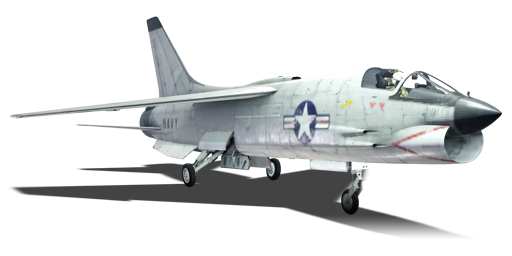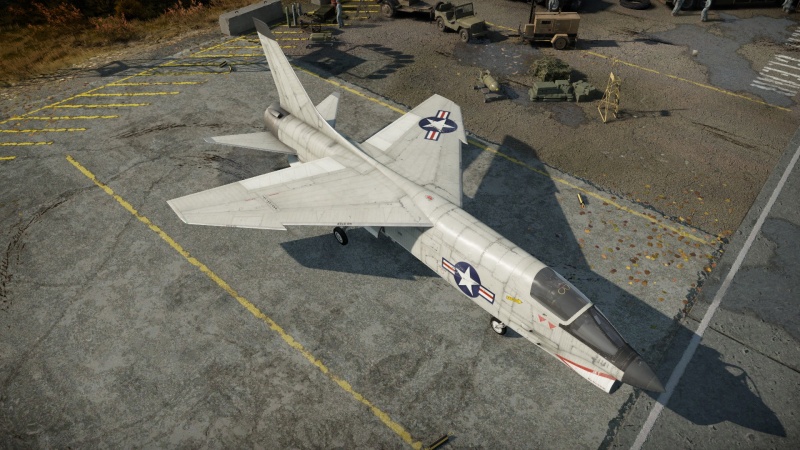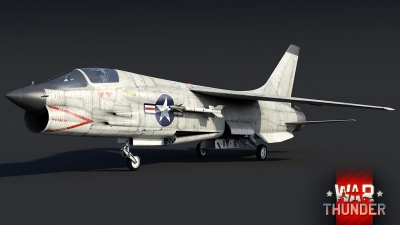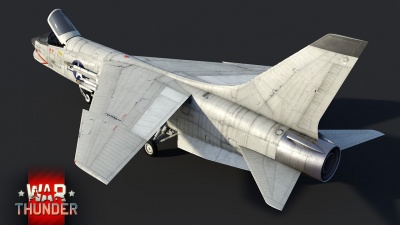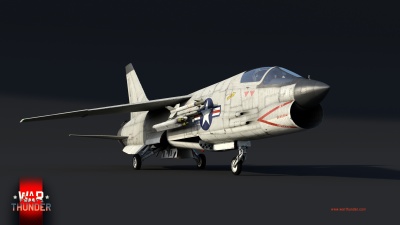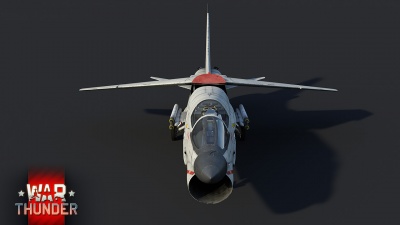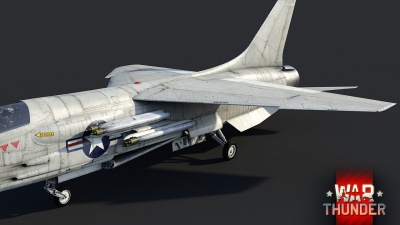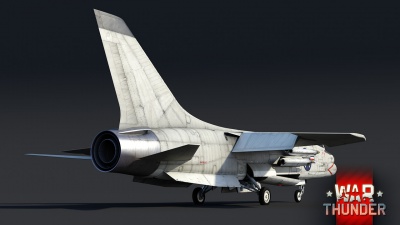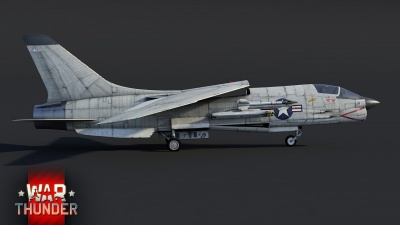Difference between revisions of "F8U-2"
m (→Usage in battles: Added a description) |
m (→Pros and cons: Some changes) |
||
| Line 214: | Line 214: | ||
* Excellent flight performance | * Excellent flight performance | ||
* Superb acceleration, even compared to top tier jets | * Superb acceleration, even compared to top tier jets | ||
| − | * | + | * Very stable, even at high speed |
| + | * Very good sustained turn rate | ||
* Landing flaps provide a lot of lift thanks to the variable wing design | * Landing flaps provide a lot of lift thanks to the variable wing design | ||
* Extendable rocket pod which fires 16 Mighty Mouses at once | * Extendable rocket pod which fires 16 Mighty Mouses at once | ||
| − | * Good radar | + | * Good radar with an identification friend or foe feature |
'''Cons:''' | '''Cons:''' | ||
* Fragile wings, can easily rip at high speeds and hard turns. | * Fragile wings, can easily rip at high speeds and hard turns. | ||
| − | |||
* Very likely to set on fire because of the fuel tank placement | * Very likely to set on fire because of the fuel tank placement | ||
* Lacks RWR | * Lacks RWR | ||
Revision as of 17:37, 10 May 2021
Contents
Description
The F8U-2 Crusader II is a rank VI American jet fighter with a battle rating of 9.7 (AB), 10.3 (RB), and 10.0 (SB). It was introduced in Update "Ixwa Strike".
General info
Flight performance
The F8U-2 is a single engine supersonic carrier-based jet fighter, its powerplant is the Pratt & Whitney J57-P-16 engine that can produce 8,000 kgf of thrust. The Crusader is able to reach 1 Mach in level flight at sea level and 1.95 Mach at 10,600 m, that puts it on par with many jet fighters like the MiG-19 or the Su-7B, but it is also slower than any F-104 and MiG-21 at low altitude. The structural speed limit is very high: 1,555 km/h IAS, reaching that speed even when the plane is diving is not that easy, so the player does not have to worry about overspeeding. Its thrust to weight ratio while not being close to 1.0 still is good enough to make the plane very good in any longer fight and makes the level acceleration very good. The F8U-2 is also decent at climbing, at sea level with full fuel tanks it can reach up to 130 m/s, however other jets like the MiG-19, MiG-21, or Su-7 are better at climbing. With the afterburner on and full fuel tanks it can fly for about 12 minutes at low altitude, flying at higher altitude (5,000 m) increases it to about 16 minutes.
Compared to many other supersonic jet fighters, the Crusader is very good at dogfighting. Although it has quite low G limits (+10G with full fuel tanks) it is capable in both shorter and longer fights because of instantaneous turn rate which can be improved by using slats with the speed limit that is 1,070 km/h IAS (slats which are not automatic are being extended by switching flaps to the combat position, also the flaps itself are being extended after switching them to the landing position) and sustained turn rate, the plane is capable of performing a full horizontal circle at sea level in 22 seconds with 30 minutes of fuel. The best sustained turn rate can be achieved by flying at ~650 km/h IAS where it reaches 16.2 deg/s, that makes it better at longer turning than many jet fighters, for example any MiG-21, Mirage, F-4 Phantom or F3H, however it will struggle below 300 km/h against anything because of high wing loading. Due to low G limits the plane is very easy to break in RB with the Mouse Aim controls, in SB it also the case, especially after switching to the damping stability augmentation system (SAS) mode, which overrides high speed locking of the elevator. The roll rate performance is above the average compared to other jet fighters, it is ~135 deg/s at 600 km/h IAS and increases further to ~210 deg/s at 1,000 km/h IAS. The airbrake in this plane is located under the fuselage, that means it is not possible to extend it and the landing gear at the same time. The most interesting feature about this plane is its variable-incidence wing design which can be pivoted by 7° out of the fuselage during the take-off or landing to make them easier, this functionality can be enabled by lowering flaps to the landing position and the minimum speed is 580 km/h IAS.
With full-real controls the F8U-2 has access to two SAS modes, manual and damping. With the manual mode it is quite challenging to fly, it is very easy to pull too much G or stall it out at lower speed. After switching to the damping mode it gets much more stable, but gets less responsive in roll axis, also makes the plane not lock up at any speed.
| Characteristics | Max Speed (km/h at 10,668 m) |
Max altitude (metres) |
Turn time (seconds) |
Rate of climb (metres/second) |
Take-off run (metres) | |||
|---|---|---|---|---|---|---|---|---|
| AB | RB | AB | RB | AB | RB | |||
| Stock | 2,025 | 2,017 | 16310 | 28.4 | 29.4 | 113.8 | 104.6 | 1,828 |
| Upgraded | 2,054 | 2,038 | 27.6 | 28.0 | 162.5 | 137.0 | ||
Details
| Features | |||||
|---|---|---|---|---|---|
| Combat flaps | Take-off flaps | Landing flaps | Air brakes | Arrestor gear | Drogue chute |
| ✓ | X | ✓ | ✓ | ✓ | X |
| Limits | ||||||
|---|---|---|---|---|---|---|
| Wings (km/h) | Gear (km/h) | Flaps (km/h) | Max Static G | |||
| Combat | Take-off | Landing | + | - | ||
| 1555 | 428 | 1070 | N/A | 583 | ~10 | ~6 |
| Optimal velocities (km/h) | |||
|---|---|---|---|
| Ailerons | Rudder | Elevators | Radiator |
| < 1000 | < 590 | < 500 | N/A |
Engine performance
| Engine | Aircraft mass | |||||||
|---|---|---|---|---|---|---|---|---|
| Engine name | Number | Basic mass | Wing loading (full fuel) | |||||
| Pratt & Whitney J57-P-16 | 1 | 8,339 kg | 341 kg/m2 | |||||
| Engine characteristics | Mass with fuel (no weapons load) | Max Takeoff Weight | ||||||
| Weight (each) | Type | 14m fuel | 20m fuel | 30m fuel | 45m fuel | 48m fuel | ||
| 1,592 kg | Afterburning axial-flow turbojet | 9,531 kg | 9,916 kg | 10,708 kg | 11,925 kg | 12,279 kg | 12,760 kg | |
| Maximum engine thrust @ 0 m (RB / SB) | Thrust to weight ratio @ 0 m (WEP) | |||||||
| Condition | 100% | WEP | 14m fuel | 20m fuel | 30m fuel | 45m fuel | 49m fuel | MTOW |
| Stationary | 4,562 kgf | 8,003 kgf | 0.84 | 0.81 | 0.75 | 0.67 | 0.65 | 0.63 |
| Optimal | 4,804 kgf (1,000 km/h) |
8,921 kgf (1,200 km/h) |
0.94 | 0.90 | 0.83 | 0.75 | 0.73 | 0.70 |
Survivability and armour
The only protection that this plane offers is a 25 mm bulletproof glass in front of the cockpit. Fuel tanks are located in the center part of the plane: in the fuselage and wings, getting hit there will most likely set the plane on fire. Flaps in this plane work also as ailerons, so losing them by overspeeding or being hit will make the plane unable to roll.
Modifications and economy
Armaments
Offensive armament
The F8U-2 is armed with:
- A choice between two presets:
- 4 x 20 mm Browning-Colt Mk12 Mod 3 cannons, nose-mounted (144 rpg = 576 total)
- 4 x 20 mm Browning-Colt Mk12 Mod 3 cannons, nose-mounted (144 rpg = 576 total) + 32 x FFAR Mighty Mouse rockets
Suspended armament
The F8U-2 can be outfitted with the following ordnance:
- Without load
- 2 x AIM-9B Sidewinder missiles
- 4 x AIM-9B Sidewinder missiles
- 2 x AIM-9D Sidewinder missiles
- 4 x AIM-9D Sidewinder missiles
- 4 x Zuni Mk32 Mod 0 ATAP rockets
- 8 x Zuni Mk32 Mod 0 ATAP rockets
- 2 x AIM-9B Sidewinder missiles + 4 x Zuni Mk32 Mod 0 ATAP rockets
- 2 x AIM-9D Sidewinder missiles + 4 x Zuni Mk32 Mod 0 ATAP rockets
Usage in battles
The F8U-2 performs the best when using tactics similar to the Hunter, which involves using your high-speed pointing and handling to break the enemy formation. However, be sure not to engage in a close combat when your speed is 900 km/h or above, since there is a great risk that your wing would break due to the overload.
The most dangerous enemies include:
- Any soviet aircraft that has an R-60: since it would be impossible to dodge the missile at high speed.
- MiG-17s: they can outmanoeuvre you in dogfights.
SB EC
The F8U-2 is a great dogfighter, it can deal with almost any fighter in EC7 bracket, its main strengths are very good sustained turn rate, radar with an identification friend or foe feature and quite good missiles: the AIM-9D. Before spawning in it is the best to select 30 or 45 minutes of fuel, its consumption is very high in combat and it is very easy to run out of it after fighting multiple enemies. Due to the presence of radar guided missiles and the lack of any countermeasures or systems like the RWR it is recommended to not fly too high, flying even at very lot altitude will work because of the excellent turning capabilities of the Crusader.
Compared to the other jet fighters with similar battle rating it has similar low altitude level speed, but planes like the MiG-21, Mirage, J35, Lightning F.6 or F-104 will easily be able to outclimb or outrun it. However all of them can easily be outturned, any delta wing jet will struggle in sustained turning, even the MiG-21bis with a very high thrust to weight ratio. Since the F8U-2 has quite high wing loading and the fact it is very easy to break wings going for scissors should be avoided, flying at low speed (below 400 km/h) also will end up badly. The best sustained turn rate can be achieved by flying with the speed range: 550 - 740 km/h, its turn rate will be ~16 deg/s without missiles and 30 min of fuel and 15 deg/s with missiles and the same fuel amount. The most dangerous delta wing plane, the MiG-21bis is worse by 1-2 deg/s and the other MiGs like the MF and earlier by 3-4 deg/s. Other planes like the Mirage or J35 are similar to the MiG-21MF, so outturning them should not be a problem, however the Mirage is equipped with the R.550 missile which can be launched from quite high angles and can pull up to 30G, so it is the best to not allow it to get anywhere near the rear of the F8U, the later MiG-21 versions can also carry a similar missile, the R-60M, which is very dangerous at close range within 2,000 m.
The most dangerous foes that this plane can meet are the MiG-19 and J32B, both are better at dogfighting and as fast as the Crusader at low altitude, engaging them without the speed and altitude advantage is not recommended, although since they carry very early missiles, the R-3S and AIM-9B, it is possible to just run away from them and easily dodge their missiles, but that will work only above 2,000 m. Both these fighters are better at sustained turning by at least 20%, their wing loading is also lower, so forcing them to one circle fight/scissors might be risky. The last plane worth mentioning is the Su-17M2, its sustained turn rate is also superior to the F8U, but since its wing loading and stall speed are so much higher it can be forced to low speed or one circle fight, it also does not have any radar except for the rangefinding one for its gun. All weapons used by that plane are very similar to the MiG-21Bis, so running away will not end well, it is also one of the fastest planes.
Radars
The F8U-2 is equipped with an AN/APQ-50 search and tracking radar. The radar is mounted in the nose of the aircraft.
| AN/APQ-50 - Target Detection Radar | |||
|---|---|---|---|
| Maximum Detection Range |
Guaranteed Detection Range |
Max Azimuth Scan Angle |
Max Elevation Scan Angle |
| 370,000 m (theoretical) |
40,000 m | ±50.0° | -8.15°/+4.15° |
| AN/APQ-50 - Target Tracking Radar | |||
| Maximum Tracking Range |
Minimum Tracking Range |
Azimuth Tracking Angle |
Elevation Tracking Angle |
| 92,500 m | 200 m | ±58.0° | ±58.0° |
Pros and cons
Pros:
- Cannons could fire separately to save ammo
- Cannons can deal serious damage, with 4 guns even a short burst is enough to destroy an enemy aircraft.
- Four AIM-9Ds, good when engaging enemies at about 3 km
- Excellent flight performance
- Superb acceleration, even compared to top tier jets
- Very stable, even at high speed
- Very good sustained turn rate
- Landing flaps provide a lot of lift thanks to the variable wing design
- Extendable rocket pod which fires 16 Mighty Mouses at once
- Good radar with an identification friend or foe feature
Cons:
- Fragile wings, can easily rip at high speeds and hard turns.
- Very likely to set on fire because of the fuel tank placement
- Lacks RWR
History
The F8U-2 Crusader was a version of the F8U Crusader that was improved from the F8U-1 in a few ways, resulting from the advent of a new P&W engine.
The largest improvement was in the addition of the Pratt and Whitney J57-P-16 engine that was rated to produce 16,900 lbf of thrust. The new engine resulted in a higher maximum speed of up to 960 knots (1777.92 kilometers per hour). Two air scoops were added to the tail cone in order to cool the more powerful (and hotter!) engine. In addition to the new engine, ventral stabilizer fins were added to the rear of the fuselage to correct stability issues. The wingspan was also reduced to 35 feet 2 inches after three inches were removed from each wingtip. A Martin-Baker F-5 ejection seat was added to the aircraft. Finally, capability to use a Y-pylon was added to carry two AIM-9 Sidewinders on each fuselage station for a total of four AIM-9 Sidewinders on the fuselage, two more than on the F8U-1.
The F8U-2 prototype was modified from the F8U-1 number four (BuNo 140477) and first flew on 20 August 1957. The F8U-2 was ordered into production and the first production F8U-2 (BuNo 145546) flew for the first time on 29 August 1958. The F8U-2 entered service in February 1959 and was redesignated as the F-8C Crusader in 1962.[1][2]
Devblog
In 1952, the American Naval command announced requirements for a new supersonic jet carrier-based fighter to protect carrier groups from enemy aircraft and achieve air superiority. Chance Vought Aircraft Inc., which already had considerable experience working with carrier-based aircraft, became one of the participants in the competition. Their candidate differed from the competition by a variable-incidence wing. The wing tilted upward by 5 degrees, which noticeably improved taking off and landings on short decks of aircraft carriers.
Just 20 months after receiving the contract, the first prototype was built for tests. The fighter successfully passed the initial tests, in the very first flight it easily broke the sound barrier, and in a modified form went to the navy for deck tests. The first prototype series was successfully tested on aircraft carriers in the spring of 1956, after which the F8U-1 Crusader entered service with the US Navy. Work on a promising jet fighter did not stop after the start of mass production. The modified aircraft with a new power plant, advanced navigation system, radar, FCS and improved armament received the designation F8U-2.
The Crusader has become a real legend and a symbol of US carrier-based aviation for its excellent flight characteristics, ease of operation, reliability and significant firepower. The fighter received the baptism of fire almost immediately after entering the service, and since then has been actively used in combat and training missions in many parts of the world, including intensive combat service in Vietnam. Even when more advanced aircraft entered service, the naval pilots were reluctant to say goodbye to the Crusaders. "When you're out of F-8's, you're out of fighters" they said.
Media
- Skins
- Images
See also
Links to the articles on the War Thunder Wiki that you think will be useful for the reader, for example:
- reference to the series of the aircraft;
- links to approximate analogues of other nations and research trees.
External links
References
| Chance Vought Aircraft | |
|---|---|
| Fighters | |
| Corsair | F4U-1A · F4U-1A (USMC) · F4U-1C · F4U-1D · F4U-4 · F4U-4B · F4U-4B VMF-214 |
| Float planes | O3U-1 · OS2U-1 · OS2U-3 |
| Attackers | AU-1 |
| Bombers | SB2U-2 · SB2U-3 |
| Jet aircraft | |
| Corsair II | A-7D · A-7E · A-7K |
| Crusader | F8U-2 · F-8E |
| Export | V-156-B1 · V-156-F · ▄Corsair F Mk II · F4U-7 · ▄F-8E(FN) |
| Captured | ▅F4U-1A |
| USA jet aircraft | |
|---|---|
| Fighters | |
| F9F | F9F-2 · F9F-5 · F9F-8 |
| F-80 | F-80A-5 · F-80C-10 |
| F-84 | F-84B-26 · F-84F · F-84G-21-RE |
| F-86 | F-86A-5 · F-86F-25 · F-86F-2 · F-86F-35 |
| F-89 | F-89B · F-89D |
| F-100 | F-100D |
| F-104 | F-104A · F-104C |
| F-4 | F-4C Phantom II · F-4E Phantom II · F-4J Phantom II · F-4S Phantom II |
| F-5 | F-5A · F-5C · F-5E · F-20A |
| F-8 | F8U-2 · F-8E |
| F-14 | F-14A Early · ▄F-14A IRIAF · F-14B |
| F-15 | F-15A · F-15C MSIP II · F-15E |
| F-16 | F-16A · F-16A ADF · F-16C |
| Other | P-59A · F2H-2 · F3D-1 · F3H-2 · F4D-1 · F11F-1 |
| Strike Aircraft | |
| FJ-4 | FJ-4B · FJ-4B VMF-232 |
| A-4 | A-4B · A-4E Early |
| A-7 | A-7D · A-7E · A-7K |
| AV-8 | AV-8A · AV-8C · AV-8B Plus · AV-8B (NA) |
| A-10 | A-10A · A-10A Late · A-10C |
| F-111 | F-111A · F-111F |
| Other | A-6E TRAM · F-105D · F-117 |
| Bombers | |
| B-57 | B-57A · B-57B |


